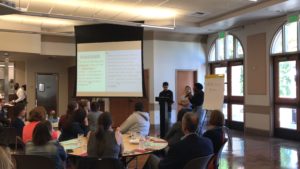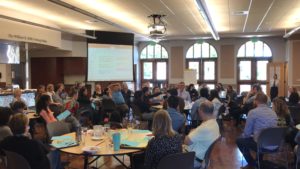“People look at Marin Oaks like its not a good school. I am so happy there. So many of us are seen as problems but we’re thriving there. We’re not a problem anymore.”
Marin Oaks is a continuation school. Where the “bad” kids go in Marin County. The kids who can’t sit still, who disrupt class, who get bad grades. They get kicked out too many times, and then it’s off to Marin Oaks they go.
And when they get there, they thrive.
They make friends and connect with their teachers. Their grades improve. They graduate. Something is different about Marin Oaks — and, whatever it is, it is making all the difference.
During the ‘17-18 school year, a group of Marin Oaks students decided to investigate that difference. The project was seeded at the launch of the school year when, during their Youth Leadership Institute meetings, they began sharing their school experiences. The similarities were immediately obvious. They wondered if other students shared these experiences — if there was a pattern — and determined that the answer was critical: it would mean that the students aren’t the problem.
In order to research this question, the youth decided to conduct interviews with other Marin Oaks students. The interviews — 20 in all — were revealing. Students described their struggles with depression and anxiety, and the lack of resources and support at their previous schools. “At traditional high schools,” said one student, “every teacher reminds you they have 120 students and 120 assignments. So you know [they’re] dealing with all these kids. They’re not worried about you at all. Basically, the teachers got too much on their plate, they don’t have time to help me.” Some young people talked about stigma, how they were treated after teachers found out about their mental health issues: “Before this whole problem, I was a normal student who attended school. Until they found out I had all this other stuff, it became a problem.” Others felt completely invisible: “Literally I was gone for so much of the day and no one cared.”
Many of the students shared stories of racism, sometimes as blatant as name-calling, oftentimes much subtler: “In some other schools I’ve gotten into problems and it’s been always the teacher that’s right, or the nicer kid with the better grades that’s been the one who’s always been believed.”
Reflecting on their experiences at Marin Oaks, interviewees quickly pointed to the teachers and staff — the way they handled conflicts, they way they listened to the students: “The difference between here and the other schools is when discipline happens, the process is really calm. Ms. Early will come up to you real calm and ask you for your opinion on what happened: ‘Alright, tell me your side of the story’.” Essentially, the students feel heard: “At Marin Oaks, they are a lot more open to us and really make us feel like our opinion and voice matters.”
This difference is crucial, as some students pointed out that: “Some people need their hand held longer. Some people need more help to get through it all…but at traditional high schools they try to treat everybody the same. That doesn’t work out for everybody.” What the other schools lacked, they were saying, was a fundamental understanding of equity.
Mental health. Staff/teacher and youth relationships. Racism. Equity. Boiled down, the patterns were clear. And if patterns can be found, so can solutions. Based on these findings, the youth leaders developed a set of recommendations for Novato Unified School District:
- Teachers, staff and students should work from a common ground of respect and not opposition.
- Teacher/staff-student relationships should be created, where both are feeling respected, heard, and safe.
- Mental health needs to be destigmatized, and more support and mental health resources should be provided.
- Individualized support needs to go beyond academic success.
- Students, staff and administration needs to be diversified.
- Racism needs to be squashed: teachers need social justice trainings.
The District Responds
While the Marin Oaks youth leaders were honing in on their research, Novato Superintendent Jim Hogeboom had spent the year working on his own investigation. He was seeing a pattern, too, and was trying to figure out how to make the Novato Unified School District more equitable. At the beginning of last year, Youth Leadership Institute had implemented Student Advocacy Councils in schools across Marin and the Superintendent sought them out for their advice. Something far-reaching was needed to address the district’s problems.
On May 31st, Superintendent Hogeboom held a district-wide Equity Convening, attended by over 100 educators and administrators from San Marin, Novato, and Marin Oaks High Schools. The meeting included a Fish Bowl, where teachers sat in a circle surrounding the youth, watching and witnessing as students conversed about their school experiences. Of all the Student Advocacy Councils in the district, the youth leaders from Marin Oaks were invited to present their project. They discussed their research strategies, shared quotes drawn from the interviews, and offered their findings and recommendations to improve the district’s schools.
The teachers and staff were blown away. And the youth had made significant progress toward their stated goal, which was to help build “schools that care for their marginalized students,” including those with mental health issues and physical disabilities, as well as students of color, queer students, and low-income students. The difference, they said, is equity: finding what is right for each student.


